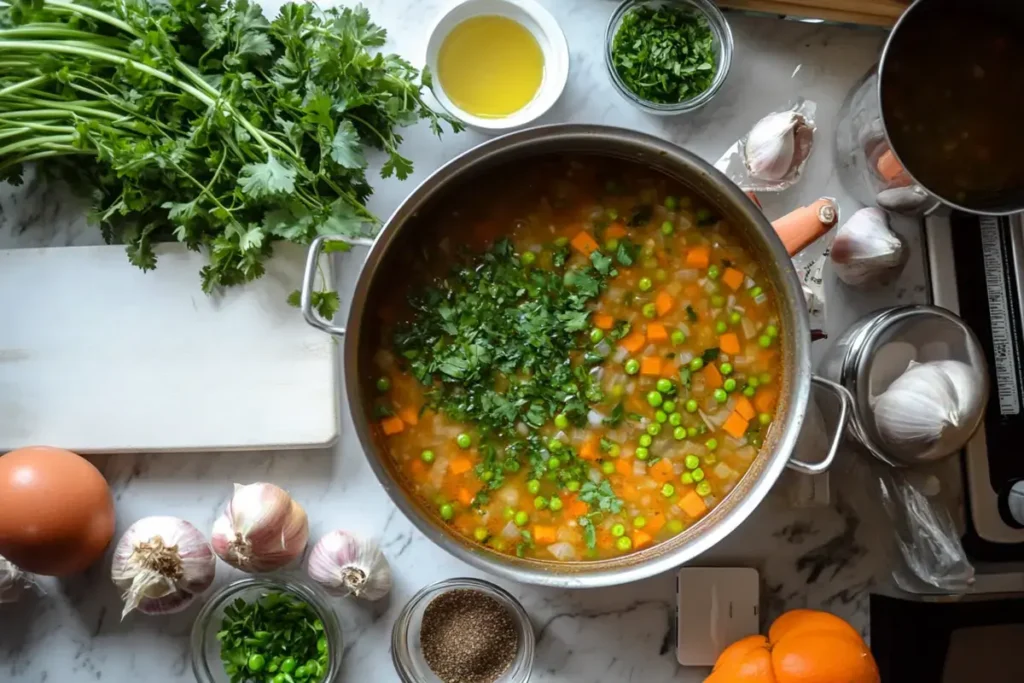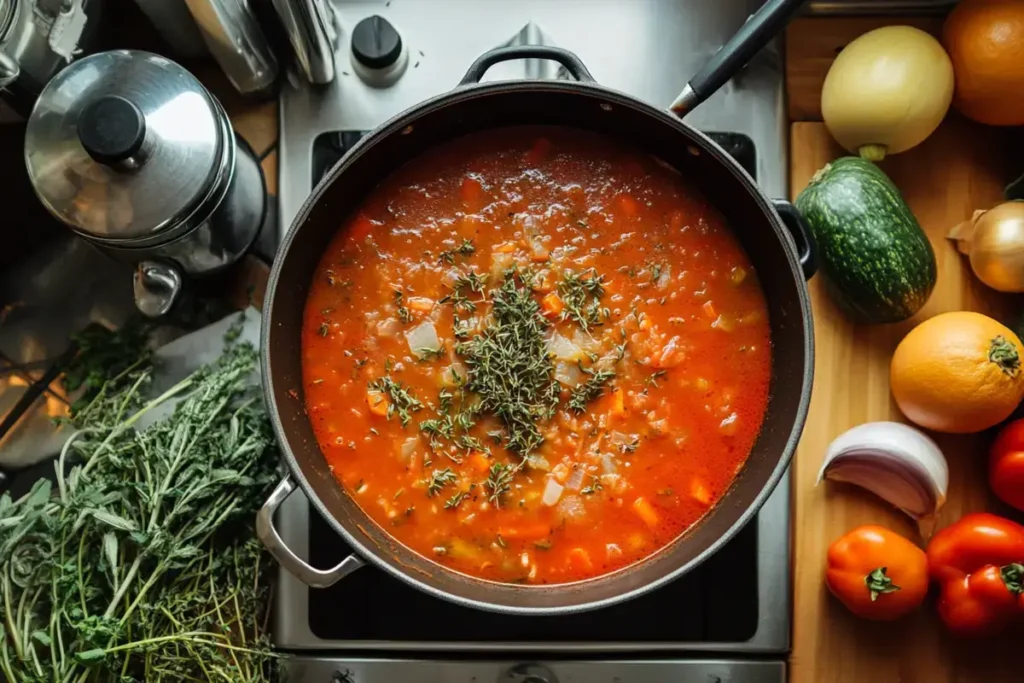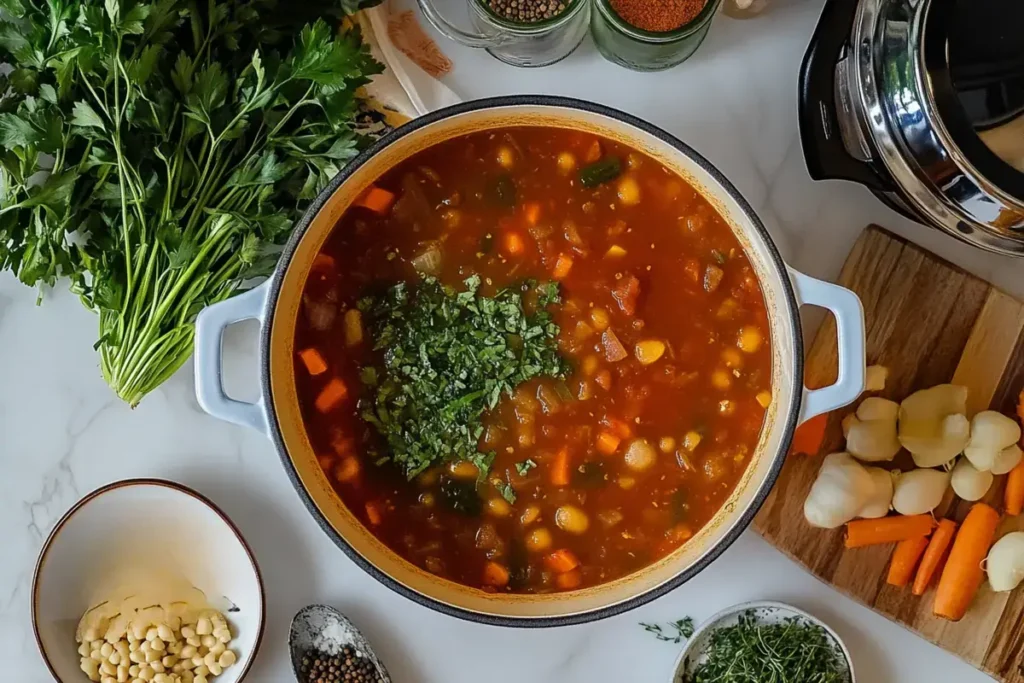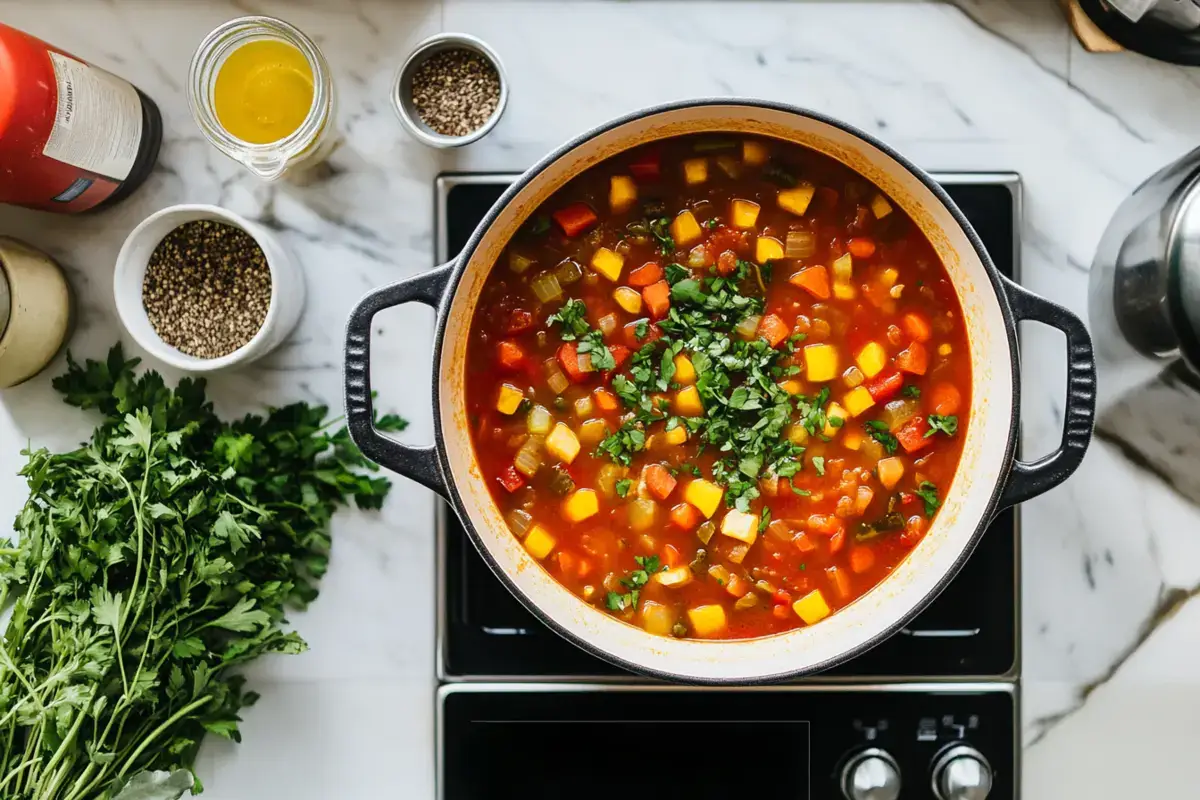Discover easy ways to boost your soup’s taste using fresh ingredients, smart techniques, and flavorful additions.
Welcome to this comprehensive guide on enhancing the taste of any vegetable soup you make. Soup often becomes a go-to meal because it is comforting, nutritious, and easy to prepare. However, it can sometimes end up bland if you stick to basic vegetables and water. Basically, you need to know What can I add to my vegetable soup to give it more flavor? In this article, we will explore countless methods to liven up a humble vegetable soup. We will cover everything from choosing the best aromatics to creative finishing touches. Consequently, you can transform any pot of soup into a delightful masterpiece. Let us now examine each element that plays a key role in elevating your soup’s flavor.
Classic Flavor Foundations
Building a robust base for your soup remains crucial for delicious results. Initially, consider the aromatic vegetables you use to begin your soup. Onions, garlic, celery, and carrots, also known as a mirepoix, form a cornerstone of rich soups worldwide. Nevertheless, you might include bell peppers or leeks for a different flavor dimension. Indeed, the starting ingredients matter.
When making vegetable soup, choose a high-quality vegetable stock. If possible, make your own by simmering vegetable scraps. That way, you can capture hidden flavors in your produce. If homemade stock is not feasible, you can still get decent results from store-bought versions. However, be sure to pick a low-sodium product and adjust salt later. Eventually, this approach helps avoid an overly salty finished soup.
Proper sautéing is another critical step. Comparatively, sautéed aromatics intensify your soup’s depth more than just tossing raw veggies into boiling water. In essence, sautéing allows natural sugars to develop, giving the soup a subtle sweetness. Conversely, skipping this step might lead to a less robust flavor. Use a tablespoon or two of olive oil and cook your aromatics until softened. Another tip is to add a pinch of salt at this stage to draw out moisture. Altogether, these foundational techniques help guarantee a more satisfying soup from the start.
Classic Seasonings
Seasonings dictate how savory and aromatic your soup becomes. So, What can I add to my vegetable soup to give it more flavor? Consider the power of good salt and freshly ground black pepper. Although they sound basic, they remain the backbone of well-seasoned meals. Many home cooks either skimp on salt or add too much at once. Ideally, season as you go to maintain control. Because salt magnifies other flavors, add it gradually and taste regularly.
Herbs deliver a dynamic burst of flavor. Oregano, thyme, basil, and rosemary pair especially well with a range of vegetables. Dried herbs require time to bloom in liquid, so add them earlier. Fresh herbs offer brighter notes, hence adding them toward the end yields a fresher taste. Nutritional yeast, on the other hand, imparts a subtle cheesiness to vegan soups. Soy sauce or tamari can bring another layer of savory depth. Meanwhile, miso paste can be stirred in at the end for a comforting umami note. Basically, these elements provide a flexible way to season your soup in creative ways.
For spicier palates, chili flakes, smoked paprika, or a dash of cayenne pepper can generate heat. Indeed, a small measure of these spices can make a big impact. Conversely, keep the soup mild if you plan to serve guests who prefer less spiciness. The objective is balance, so do not overshadow the inherent sweetness of vegetables. Eventually, with the right classic seasonings, you create a foundation that sets the tone for all other additions.

Protein and Hearty Add-Ons
Hearty additions ensure your soup has both taste and nutritional value. What can I add to my vegetable soup to give it more flavor? You can start by adding beans, chickpeas, or lentils. Not only do they increase protein content, but they also provide a creamy texture. Generally, these legumes soak up the surrounding flavors, helping them meld into the soup. Likewise, for vegetarian meals, tofu cubes can be added for extra substance without altering the primary flavor.
If you eat meat, consider chicken stock or beef stock for a deeper backdrop. Chicken stock, for example, can lend subtle richness without overpowering the vegetables. Similarly, beef stock might add a robust quality, especially if you use roasted bones. However, ensure any meat-based broth complements your chosen vegetables. Because certain stocks could overshadow more delicate produce, proceed with caution if you want to keep your soup’s vegetable essence intact.
Furthermore, grains such as rice, quinoa, or barley introduce chewy texture and added filling power. Cook them separately to avoid overly starchy soup. Afterward, stir them in and let them absorb surrounding flavors. For a silky mouthfeel, add a splash of cream or coconut milk. Coconut milk, particularly in soups with sweet potatoes, peppers, or tomatoes, can add a luxurious taste. Conversely, heavy cream or half-and-half forms a mild, velvety thickness. Undoubtedly, these protein-rich or creamy additions make your soup more satisfying.
Depth Through Acidity and Richness
Acidity is an underrated enhancer of vegetable soup. A splash of vinegar or lemon juice near the end can turn a flat broth into a bright, lively dish. Chiefly, the tanginess cuts through heaviness and enhances the natural flavors of vegetables. Tomato paste is another secret weapon for richer taste. By sautéing it with the aromatics, you develop intense caramelized tomato notes. Consequently, your soup gains a richer hue and heartier profile.
Sweetness occasionally becomes essential to round out acidic or bitter flavors. A teaspoon of sugar, honey, or maple syrup can balance tangy tomatoes or bitter greens. Additionally, a hint of sweetness can help unify the soup’s taste, resulting in a cohesive flavor profile. Nonetheless, be careful with the amount, as you do not want a sweet soup unless your recipe explicitly calls for it.
Roasting vegetables before adding them to your soup pot significantly boosts depth. Carrots, tomatoes, and onions, for instance, develop richer undertones when caramelized in the oven. Place them on a sheet pan, drizzle with olive oil, and roast until lightly browned. Because this process intensifies their flavors, your soup will taste more complex. Eventually, these steps showcase how adding acidity and richness can transform a simple soup into a gourmet creation.
Flavorful Finishing Touches
Once your soup has simmered, it is time for finishing touches. What can I add to my vegetable soup to give it more flavor? Fresh herbs like parsley, dill, or cilantro deliver brightness. Chop them finely and scatter on top just before serving. This technique preserves their color and delicate taste. Another option is shredded cheese. For instance, a sprinkle of Parmesan, cheddar, or crumbled feta can enhance both richness and texture. Nevertheless, do not be heavy-handed with cheese. You only need a small amount to achieve the desired effect.
Infused oils impart aroma and body. A drizzle of chili oil or garlic-infused olive oil completes a bowl of soup with an appealing sheen. Equally, a swirl of sour cream, yogurt, or crème fraîche can add a tangy element. If you prefer plant-based alternatives, swirl in vegan sour cream or coconut yogurt. Indeed, these final garnishes draw attention to every spoonful.
For more crunch, toast some pumpkin seeds or make quick garlic croutons. The contrast between soft vegetables and crunchy toppings can be quite enjoyable. Meanwhile, consider adding a pinch of finishing salt. Flaky sea salt gives a delicate, crunchy texture that complements the soup’s warm flavors. Consequently, these flavorful finishing touches can provide a restaurant-quality feeling in every bowl.

Spices and Herbs
Spices and herbs play a pivotal role in any soup’s taste. Thus, What can I add to my vegetable soup to give it more flavor? Start by understanding the difference between fresh and dried herbs. Dried thyme or oregano might taste more concentrated, so use them sparingly if you are not accustomed to their potency. On the other hand, fresh herbs such as basil and parsley are milder but supply bright, garden-fresh notes.
Warming spices can change a typical vegetable soup into an extraordinary dish. Cinnamon, nutmeg, or even a dash of allspice can complement butternut squash, sweet potatoes, or carrot-based soups. Chiefly, a small pinch of cinnamon can yield a surprising warmth without making the soup taste dessert-like. Furthermore, curry powder or cumin might give your soup a global flair. Because these spices are quite robust, add them gradually, tasting frequently to gauge the right balance.
The timing for adding herbs and spices matters. Generally, add dried herbs earlier to let them fully infuse. Conversely, add fresh herbs toward the end to preserve their brightness. This approach ensures a layered taste that does not feel muddled. Equally, be open to experimenting with spice blends. Garam masala, herbes de Provence, or za’atar can turn your everyday vegetable soup into an unforgettable meal.
Innovative Strategies
Occasionally, you may find inspiration beyond classic methods. What can I add to my vegetable soup to give it more flavor? Innovative strategies can come from repurposing leftovers or using unexpected ingredients. For example, leftover tomato sauce, pesto, or salsa can bring depth to your broth. In particular, tomato sauce adds body and sweetness. Pesto contributes herbaceous richness, while salsa imparts zesty brightness.
If you enjoy global cuisines, consider exotic spice mixes. Ras el hanout from North Africa or berbere from Ethiopia can expand your flavor horizons. Meanwhile, harissa paste adds smokiness and gentle heat. Another creative approach is blending roasted vegetables into the soup. Blending a portion of roasted peppers or eggplants can thicken the soup naturally. Basically, you infuse it with a roasted essence that plain vegetables might not achieve on their own.
Look for ways to use fermented ingredients. Kimchi or sauerkraut brine offers a tangy punch, albeit in small doses. Miso, as mentioned before, can be stirred in at the end to preserve its probiotic benefits. Be sure not to boil it, or you lose some of those beneficial properties. Generally, if you remain adventurous, you will find plenty of unconventional ways to electrify your vegetable soup.
Topping Ideas
Toppings might seem like a minor detail, but they can significantly elevate a soup. So, What can I add to my vegetable soup to give it more flavor? Crunchy elements can provide appealing texture. Croutons, toasted nuts, or seeds like sunflower or pumpkin seeds supply a pleasant contrast. It is best to add them right before serving so they retain their crispness.
Fresh garnishes bring color and vibrancy. Microgreens, thinly sliced scallions, or fresh citrus zest can brighten every spoonful. Zest from lemons, limes, or even oranges can add a subtle tang. Additionally, you might create a swirl of pesto, hot sauce, or even barbecue sauce for something bold. Because these toppings rest on the surface, they greet your senses first, making each spoonful more engaging.
When entertaining guests, set up a toppings bar. Provide an assortment of garnishes like shaved Parmesan, crushed tortilla chips, chopped herbs, or chili oil. Undoubtedly, letting everyone customize their own soup fosters creativity and fun. Toppings help you transform a straightforward soup into a personal masterpiece. Ultimately, your meal becomes a unique dining experience.

Conclusion
In summary, understanding What can I add to my vegetable soup to give it more flavor? involves looking at every stage of the cooking process. Start by selecting quality produce and sautéing aromatics. Then, layer in herbs, stocks, or protein-rich additions for heartiness. Build depth with acidity or sweetness, and finally, elevate the soup with thoughtful garnishes and toppings. Indeed, the key is balance. Do not overpower the natural goodness of vegetables with one dominating taste. Instead, combine harmonious ingredients that complement each other.
Moreover, do not fear experimentation. Vegetable soup stands among the most forgiving dishes for novice and experienced cooks alike. Basically, every new ingredient you try can unlock an entirely fresh dimension of taste. By using the techniques described, you can create soups that burst with life. Consequently, your friends and family will be impressed by your culinary creations. Through careful layering of flavors, a simple pot of vegetable soup becomes a rewarding, restaurant-quality meal at home.
FAQs
How to improve the flavour of vegetable soup?
To improve flavor, begin by sautéing aromatics like onions, garlic, and carrots. Additionally, use quality stock, season incrementally with salt, and incorporate fresh or dried herbs. Eventually, finish with something bright, such as lemon juice, for extra liveliness. A small spoonful of sugar can also balance acidity.
How to add depth of flavor to vegetable soup?
Chiefly, roast your vegetables before adding them to the soup. Roasted carrots, onions, or peppers intensify natural sweetness. Equally, try incorporating tomato paste early in the cooking process. A splash of vinegar or wine in the final stages can give complexity as well.
How do you fix tasteless vegetable soup?
Taste your soup and adjust seasonings. If it lacks salt, add a pinch at a time until flavors pop. If it feels flat, mix in a splash of acidity like lemon juice. For a savory boost, stir in soy sauce, miso, or nutritional yeast. Meanwhile, fresh herbs or a swirl of pesto can further revive bland soup.
What to add to vegetable soup for extra flavour?
Focus on umami-rich ingredients. Nutritional yeast, miso paste, and soy sauce all lend savory depth. Try tossing in beans or lentils for a heartier texture. Finally, top it off with fresh herbs, cheese, or crunchy croutons. You can also drizzle chili oil, garlic oil, or a flavored oil to add pizzazz.

